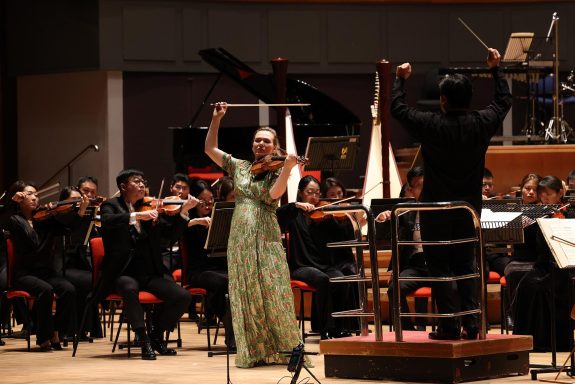 United Kingdom Tan Dun, Chausson, Saint-Saëns, Respighi: Jaipeng Nie (cello), Tamsin Waley-Cohen (violin), Shenzhen Symphony Orchestra / Daye Lin (conductor). Usher Hall, Edinburgh, 17.3.2024. (SRT)
United Kingdom Tan Dun, Chausson, Saint-Saëns, Respighi: Jaipeng Nie (cello), Tamsin Waley-Cohen (violin), Shenzhen Symphony Orchestra / Daye Lin (conductor). Usher Hall, Edinburgh, 17.3.2024. (SRT)

Tan Dun – Crouching Tiger, Hidden Dragon (excerpts)
Chausson – Poème
Saint-Saëns – Introduction and Rondo Capriccioso
Respighi – Fountains of Rome; Pines of Rome
The Chinese city of Shenzhen might well be the most globally important city that you have never heard of. Sitting on the mainland right next to Hong Kong, it is effectively the birthplace of the Chinese economic miracle. Seeking to open up the Chinese economy in the 1980s, Deng Xiaoping set up a number of Special Economic Zones that qualified for special government investment and tax breaks to promote economic growth. Shenzhen was the first, and it ballooned from a city of about 30,000 in 1980 to its current population of around twenty million.
I visited in 2018, and it is probably the closest place to Blade Runner that I have encountered in real life; a stunning conglomeration of multi-lane motorways, thriving consumer outlets and eye-popping skyscrapers. And with great wealth comes cultural cachet. They have a gleaming concert hall that, when I was there, was advertising upcoming visits from classical stars like Anna Netrebko, Antonio Pappano and the Orchestra dell’Accademia Nazionale di Santa Cecilia.
But they also have their own orchestra, currently on tour in the UK, and their stop in Edinburgh carried special significance because Edinburgh and Shenzhen have been sister cities for five years now. In fact, the concert began with a video message from the Mayor of Shenzhen, projected onto a giant screen (in a manner slightly reminiscent of 1984) that celebrated their arrival in Edinburgh to play ‘the music of friendship’. I’ll drink to that, regardless of what you may think of Chinese politics.
I guess I was expecting that, like a lot of recently formed orchestras, their sound would be bright, shiny and perhaps a little superficial, using size to make up for subtlety. In fact it was much better than I had feared, though their opening number was hard to love. Tan Dun, who wrote the score for the film Crouching Tiger, Hidden Dragon, rearranged a collection of the movie’s music as a cello concerto from which, rather oddly, we heard three of the six movements. If you have seen the film then you will know that Tan uses the music to evoke Chinese tradition and myth, with a prominent part for the cello that here took centre stage. These three movements couldn’t break out of their film-based straitjacket, sounding like movie extracts rather than a fully worked-out concerto, and with rather too much repetition instead of musical development. Cellist Jaipeng Nie played it very efficiently, with lots of oaky glissandi to mimic Chinese traditional music, but he didn’t have much to work with in a piece that doesn’t seem quite to have found its concert hall life yet.
The orchestra played it with commitment though, and, importantly, with scale. Any orchestra that brings ten double basses on its tour is not to be messed with, and the sheer heft of the sound was something to behold. Say what you like about Chinese soft power, but can you think of any other force that could summon a musical army like this to the UK? That size, combined with the forthrightness of their sound, made them pretty much ideal for Respighi’s Fountains and Pines of Rome. Maybe conductor Daye Lin dialled up the crescendo a little too quickly at the start of Fountains, but the orchestral playing was still full of lovely detail with clean, undulating strings and beautifully polished wind solos, as well as a lovely twinkle to the evening scene. True, the clarinet solo in Pines was a little too forceful, and I almost had to reach for my sunglasses during the glittering opening at the Villa Borghese, but nobody goes to The Pines of Rome for subtlety, and the way arts funding is going in the UK, we might never again hear a British orchestra with the forces to raise the roof the way they managed to at the ending.
And anyway, there was plenty of subtlety from British violinist Tamsin Waley-Cohen, who joined them for two half-concertos, creating a focused, fluent core of sound in Chausson’s Poème and a constantly delightful sense of mischief in Saint-Saëns’s Introduction and Rondo Capriccioso.
The orchestra’s encore? What else but a sweeping, luscious rendition of Auld Lang Syne from which the aural syrup was positively dripping. At least you have to credit them for knowing their audience.
Simon Thompson
